Web Design: Geoff Roynon |
Last Update: 5th November 2020 |
The history of Glebe Allotments.
In October 2007, initial contact was made to the Glebe Land Manager enquiring about resurrecting the old unused allotments on Cuddesdon Road. These allotments had been unused for 40 years.
Over a period of 2 years, Horspath Allotment Association (HAA) was created, a chairman was appointed, Peter Ewart, and honorary president, Heather Palmer negotiated the lease for the Allotments and recruited enough people to take on plots.
In July 2009, the area for the HAA is marked out with posts. In September 2009 the site was sprayed, in October 2009 the site was ploughed. In December 2009 a site plan was drawn up and the allocation of plots commenced. The committee appointed a secretary Peter Frankum. In March 2010 the site was harrowed and the front hedge cut by a working party made up of the new members and their families.
In April 2010, The HAA joins the National Society of Allotment and Leisure Gardeners, membership number S3616A. On Easter Sunday, plot holders move on to their allocated plots.
In November 2010 the first HAA Annual General Meeting takes place.
In 2013, an irrigation system was installed by Nigel Webb and Tim Rowse. Their efforts ensured water throughout the site by way of stand pipes along the main tracks.
In November 2013, Peter Ewart stood down from the position of Chair, and Fiona Smith was elected onto the position. Nigel Webb was elected as Vice-Chair. For a full list of committee members, see below. A 20 year lease was secured, and rents became payable.
We have 27 working plots, and more plots under negotiation. The site now has a social area, secure storage and secure gates.
Committee Members (July 2019)
Chair - Fiona Smith
Vice Chair - Nigel Webb
Treasurer - Rob Judges
Committee member - Steve Turnbull
Committee member - Tim Rowse
Committee member - Cath Riley
Committee member - Chris Pym
Committee member - Melissa Swan
Committee Member - Chris Goss
Secretary - Vacant
(A pdf version of the following article can be downloaded from the "Documents" page.)
Early Horspath allotments and the beginning of the Horspath Allotment Association
Origins of the Village Allotments at Enclosure.
The key piece of Parliamentary legislation that enabled the establishment of our village parish allotments, was the General Enclosure Act of 1845. It contained a clause empowering the Commissioners to "allot land for the Labouring Poor" and made special mention of "recreation grounds". Thus at Horsepath Enclosure in 1847, the ancient Anglo-Saxon open-field strip farming method was abolished by Act of Parliament. Those Horsepath peasants dispossessed of their ancient individual strips, mainly to the south of the village and around the site of Old Horsepath, were then granted small plots within the newly established Parish Allotments.
NB: Those lands to the North of the village had been enclosed in stages back in earlier times (as far back as Tudor times in some cases).
And these early enclosures - mostly quasi-legal land grabs by powerful landowners - led to frequent armed rebellions by those so dispossessed.
See below for just one example:
Oxfordshire Rising of 1596
Other local disturbances primarily caused by enclosures:- The Captain Swing riots of Otmoor)
After the 1847 Enclosure, some of the Horspath lands so released were sold off to the larger village farms. All the farm-houses themselves were still within the village itself at that time and often farmed many remote open field strips scattered across the parish in a highly uneconomic way. Often these farmers had access to some of the best of the new lands. Hence Hill Farm & several others were built on land close to the new fields. The dispossessed peasants' new Parish allotments were not so lucky and often got the poorer land! But the biggest new landowners; Brasenose, Magdalen, and Corpus Christi colleges are still major land-owners in the village to this day.
As contentious as it was, with the poorer classes deprived of their own means of subsistence and thus becoming essentially merely
a paid work-force of the bigger farmers (albeit with their rented and far smaller parish "allotments"),
this greatly improved productive use of village land allowing
a far larger population to be fed over time.
Concentrating agricultural land into larger units with fewer (capital-rich) owners allowed significant technical
developments: clay-pipe drainage, scientific crop rotation and the introduction of artificial manures
(shiploads of bird-droppings - guano - from South America).
NB: Chemically produced nitrogen is still one of the mainstay fertilisers used by Denis and George Walker today, along with
hundreds of tons of organic cattle manure from their cattle barns.
Within a few years of Enclosure it is estimated by some historians that crop yields in general increased three-fold... Progress!
For much more information on this truly revolutionary change in Horspath village's affairs see: British History - Horspath Parish
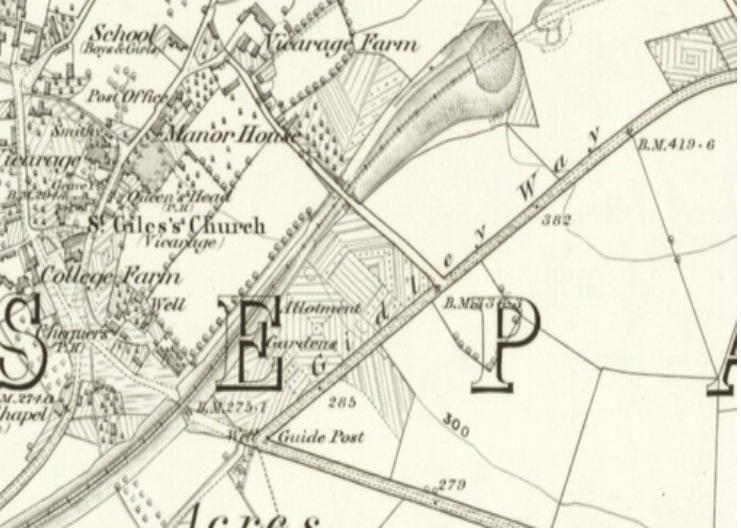
Map evidence for earlier allotment sites within the parish. About 1880.

1925. Some allotments at least lie to the West of the church. Presumably due to house-building on the land below Butts down to the bridge, and perhaps due to the increased demand for allotments during the First World War.
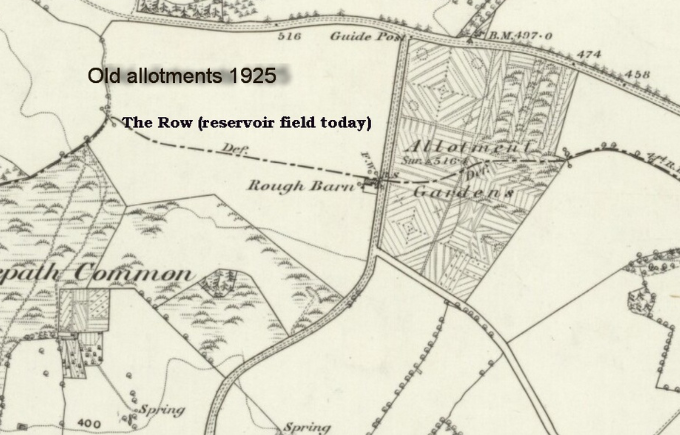
Again in 1925, the field opposite The Row on the Wheatley side has what appears to be ? 50-70 plots. Presumably these were granted after the Gidley Way plots had been built on. (Possibly Glebe land?). This field is still owned by Horspath Parish Council.
At some stage before WW2 the village Glebe plots were moved to fields south of the village along the Cuddesdon Road, but details of that transfer are currently lacking. (We need access to the Vestry Records of the parish church to research this.)
NB: the fields we are using today have considerable antiquity! Mary discovered the site of a Mesolithic campsite with
worked flint tools flakes, just south of the bee garden. (approx 5000BC) Most probably it has been alongside a small stream that was the
prehistoric outflow of our present spring.
The fields were certainly in use during later Roman times as shown by the discovery just inside the present gate of two denarii of Constantine the Great
(ruled AD 306 - AD 337); and a scattering of late 4th century Oxfordshire greyware - [coarse domestic pottery, about AD 350, from the Roman kilns
near Open Brasenose] - on the Glebe plots further up the hill. These sherds would have come from a Roman Villa's kitchen midden (Wheatley?) spread out on the
fields as manure.
Plus the recent discovery by Ivan Wright of an ancient trackway leading (probably) from Old Headington, down the Ridings, linked in Roman times
to the main Roman road through this area, across the top of our allotment site - a road we still use - and probably onward towards the Roman Villa
area and beyond.
In Medieval times this track also linked the (present) Horspath to the now lost village of Old Horsepath. There are indications that this track
may well have been in use during the Bronze Age. For further background to this fascinating story, see the Horspath Archaeology & History Groups'
website under "Documents": HAG Website)
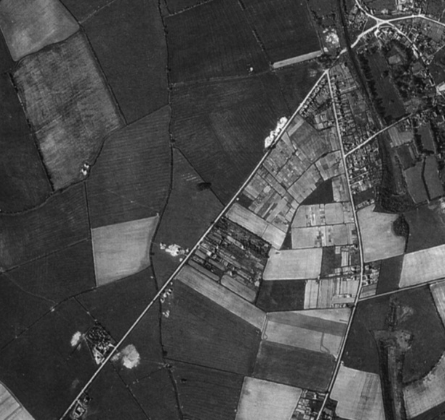
By the end of the war there appear to have been upward of about 100 plots in use. [from USAAF photo 1945]
The Glebe Allotments and the foundation of the HAA
By 1986 only two of these Glebe plots (for explanation of Glebe see:- Glebe Land) had remained in use and the rest were a tangle of brambles & knee-high weeds. The road hedge had also expanded to over 30ft on the land side.
With courteous help from Andrew Robson of Sidley's (the Land Agent for the Diocese), myself and Mary & one other local gardener (Tony Graham) then took on two of the derelict plots and began clearing them for use by hand. The gradual renting and clearance of all the other derelict plots was a slow process as we both had jobs that took us overseas on a regular basis; so it was another 15 years before the allotments were back in good shape. One major problem was the poor drainage and therefore acidic soil, which needed much added work before crop planting could be considered. However, by 2001 nearly all the formerly derelict plots had been drained, improved and were producing crops.
All this time the allotment site itself had been under threat from "developers". We had been warned that our tenancy could not be guaranteed beyond 2003. But once all the land was productive we had a measure of security under 1950 Allotments Act, which greatly deterred the "change of land use" formula necessary for "developers" to gain access. A close call.
In September 2007 however, a start was made within the Horspath Parish Council to begin a new village allotment organisation to recover an even greater area of former allotment land that had in the meantime become agricultural fields.
The full details of this splendid campaign by Heather Palmer and others are on the village website:- Horspath Village Website
Work then began on laying out the new plots under Peter Ewart's stewardship. He became the first Chairman of the new "Horspath Allotment Association" which then continued to prosper under Fiona Smith's mandate after Peter had laid down the baton after some three years of pioneering responsibility.
Fiona continues to this day as Chair and under her management she has sought to improve the HAA's viability by working closely with the Parish Council to obtain several serious grants for modern gardening machinery (all available to rent for tenants) and greatly added site security.
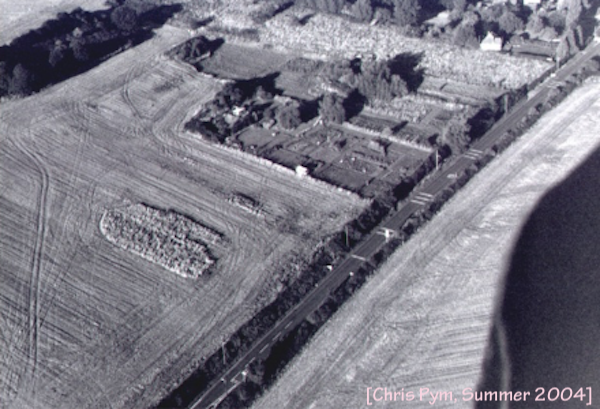
The original farmland before ploughing. Microlight photo. Chris. Summer 2004

Photo taken in the Bleak Midwinter of 2009 after the old farmland had been ploughed up.
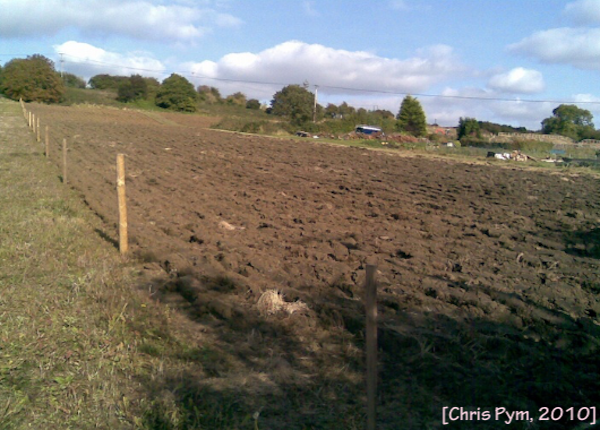
The following year things were looking better!
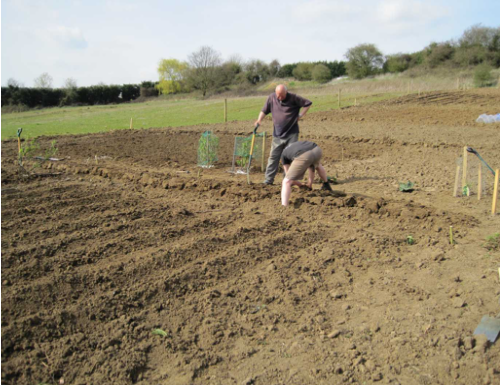
And by 2011 all the plots were under cultivation:
Nige and Peter (plots 7 & 8)
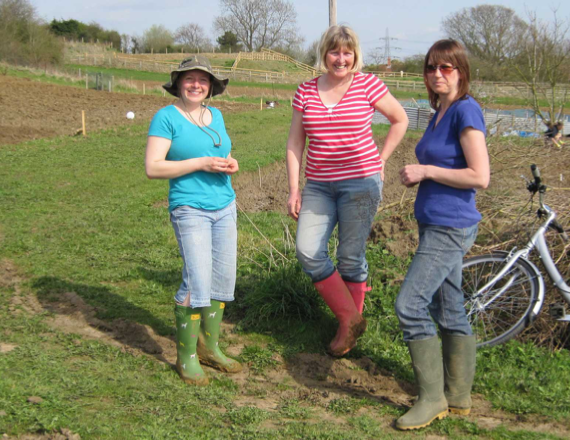
Becky, Paula and friend enjoying the summer sun.

Steve hard at work on plot 13. And the overgrown hedge had been cut back as well.
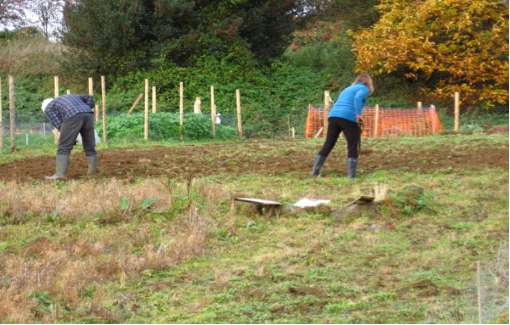
Melissa and Bob getting their plot 18 ready for planting.
We held our first celebratory get-together in Summer 2011 along the top track:
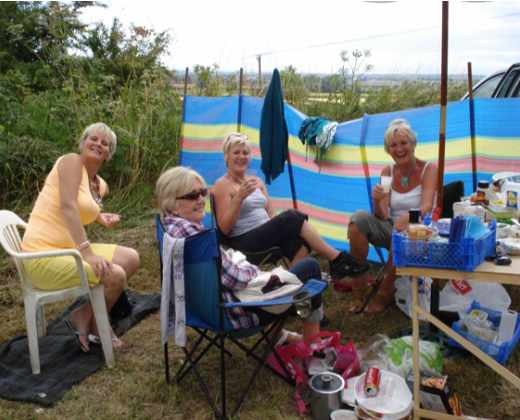
Julie, Mary, Valerie and Cath
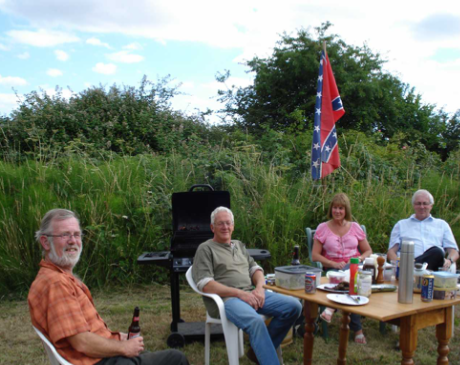
Peter, Chris and two guests from Marston. The tall plants behind are invasive Mare's Tail weeds!
At the next AGM Cath, given her long experience in managing the student catering at Brookes University Wheatley Campus, was unanimously voted in as official "Entertainments Officer".
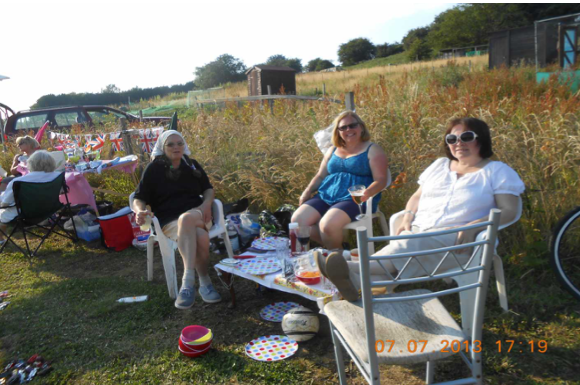
Her first official BBQ was held in July 2013 along the lower cross-track: Mary, Fiona and Natalie.
Cath has continued in this role ever since, presiding over many a memorable social event. The sheer volume of empty wine bottles and beer tins collected the following day bear testimony to these (somewhat blurred) events... But we had earned it!
In July 2013, Peter decided to install a fancy new wooden gate to replace a tatty old metal barrier that I had welded up from scrap metal. The occasion was marked by a celebratory work party for some reason as the gates had already been installed, but obviously we had some clearing up to do! Any excuse...
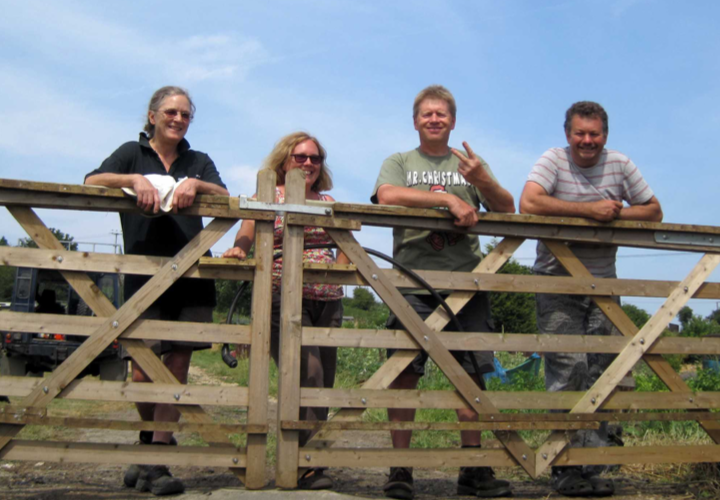
Mary, Fiona, Nige and Tim on the new gate.
One major, and wonderfully serendipitous development in 2013/14, was the rediscovery of a copious hill-side spring, the outfall of which was high up near the very top of the site. Gravity rules...
Our neighbour Brian Sellwood remembered its whereabouts from his father's time on these plots many years before: he subsequently found it and we started to clear the area as soon as possible.
NB: We took great pains to establish that our interdiction of this spring would not contravene Water Board regulations! See: Defra Exemptions
"The normal licensing threshold will continue to apply, however, which means that only abstractions of more than
20m3/day in aggregate from a source of supply will need to apply for an abstraction licence.
Therefore, if you abstract less than 20m3/day of water you will still be exempt from the requirement to obtain a licence."
And so it proved. The Abstraction Laws (above extract) clearly state that a spring volume flow of less than 20 cubic metres per day (20,000 litres) or 4,400 gallons per day, does not require a licence.
Our spring at best is approximately a quarter of that!
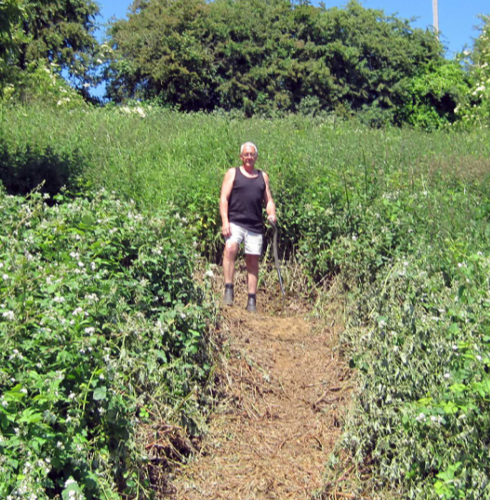
Digging out the old spring outlet.
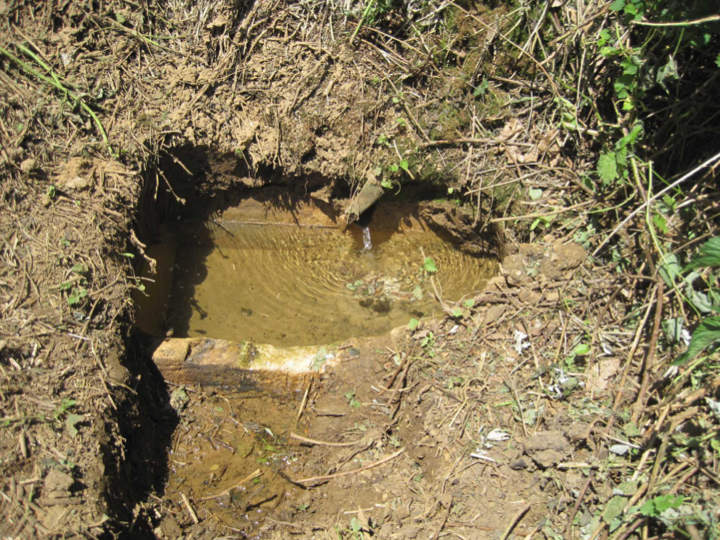
Old spring outlet with original Belfast sink and metal spout.
The overflow discharged into a stony ground "sump" and what appeared to be another outlet towards Brian's land. Brian told us that it was once - probably pre-war - connected to the downhill plots by means of a wooden aqueduct.
Once the spring had been located and dug out, we decided on a water distribution system to service all the plots (one standpipe to every two or three plots).
Nige and Tim were the obvious project supervisors, given their skilled engineering background.
Luckily, over the years I had been amassing offcuts of various diameter plastic water pipes from Nick Talboy's waste skips in Manor Farm, with the intention of "one fine day" installing a water supply to the Glebe Allotment plots. This was put on the back burner as I had no idea how to use them effectively! The pipes were thus turned over to the HAA and came in very useful in keeping our project's costs down. In fact out overall expenditure on this project was minimal.
Nige had also located two large disused water storage tanks from the old pig-farm buildings on Sandy Lane and we brought them down to the allotment site.
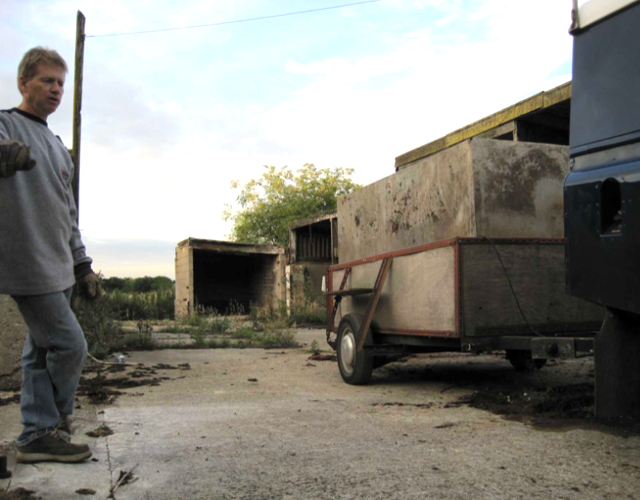
Nige looking rather dubious! First water tank en route from the pig farm.
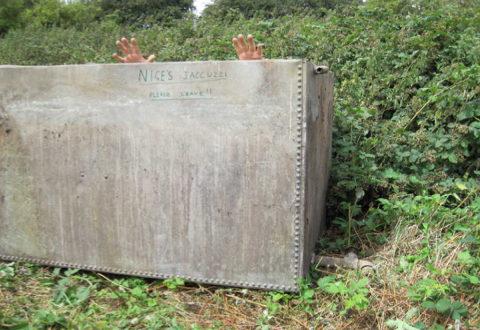
Delivered!
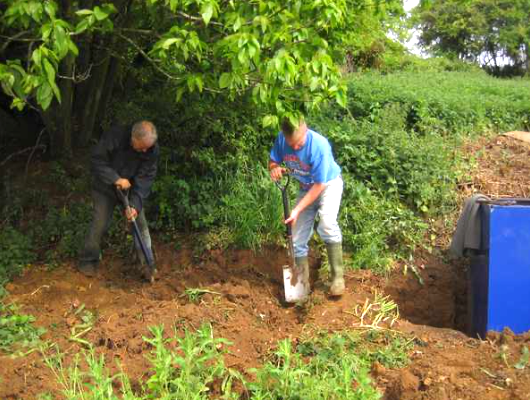
Paul and Nige digging out foundations for the water tanks, now painted and waterproofed inside.
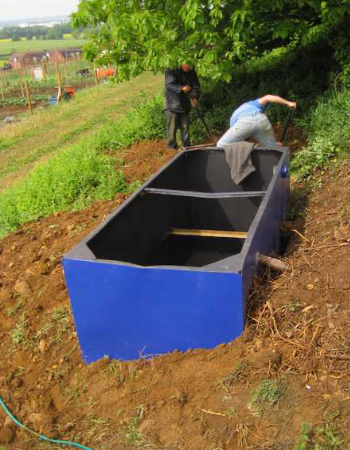
First water tank now installed and levelled.
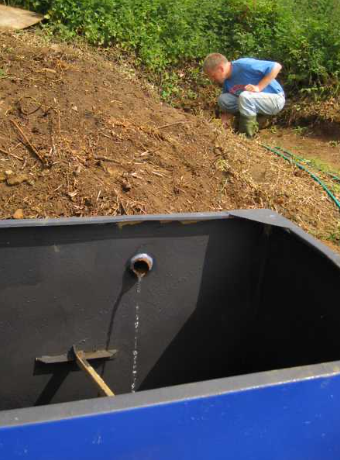
Nige finally connecting the water tank to the spring!
By 2014 we had hired the necessary equipment and then began the long process of laying the connecting pipes and standpipe taps with Tim and Nige running the operation.
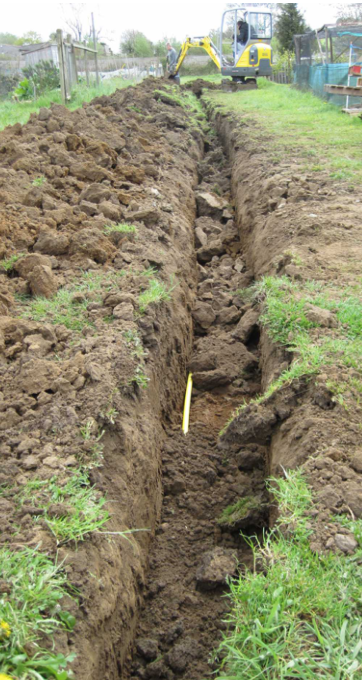
Tim on the excavator
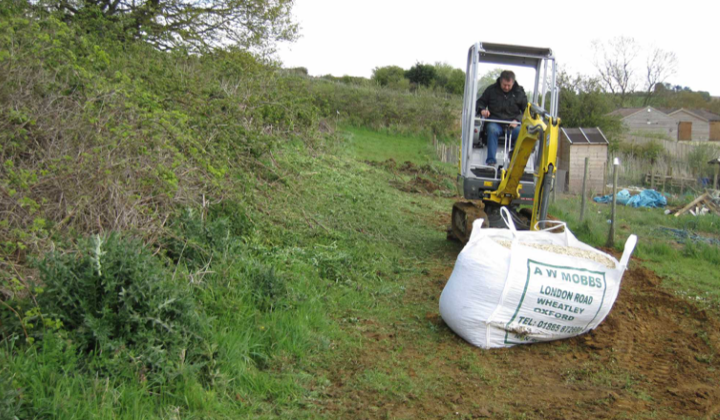
Trench ballast en route to backfill trenches. Tim driving.
The bag handles broke shortly after the photo was taken (Language!) but as usual Tim kept his calm and figured out a clever workaround.

A T-junction in process.
During this four day operation over a bank holiday in May 2014, our old shed, a recycled derelict 1930s garage, was used as our "British Restaurant". (it was later destroyed by an electrical fire when heavy snow brought down 11k voltage overhead cables on it! We got compensation after a long, exhausting fight with the SSEB though!)
Becky and Cath (with Fiona, Mary and Julie) provided a non-stop stream of egg and bacon baps and limitless coffee for the hungry work-gang.
Becky's fabulous dessert cakes are still talked about today... More please Becky!
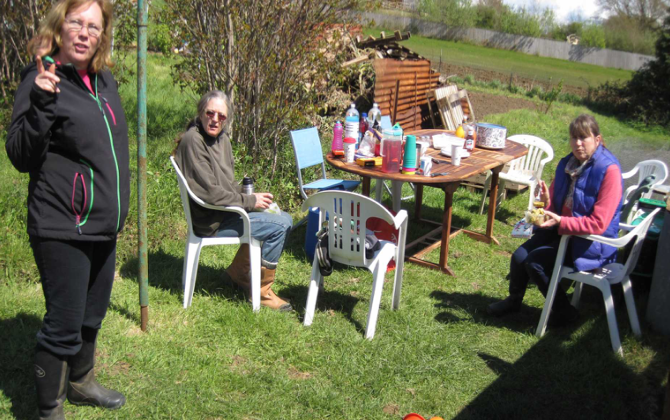
Fiona, (giving the cameraman very clear orders) plus Mary and Becky clearing up after lunch...
About this time Mary started to take an interest in the disastrous plight of our bees. Bee colonies across Europe (and the U.S.) were collapsing at an unheard-of-rate and even municipal authorities had taken to planting bee-friendly flowers in public areas. Pesticides and herbicides were suspected and some were banned by the E.U., but the jury is still out for other reasons.
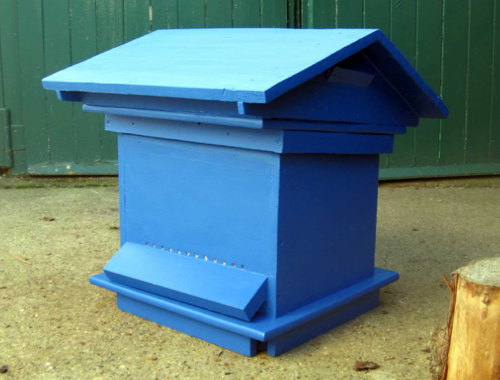
Ornamental bee-hive after repainting.
So we followed suit and the "pollinator garden" alongside the main track was thus born with Mary in charge. A home-made (and totally useless!) ornamental hive was repainted and brought up from her garden at home and placed at the top of that plot. Above, the totally ornamental bee-hive after repainting. It was a simple empty box as I had then no idea at all what the insides should look like.
Nige then took charge and with the timely assistance of the noted village bee-master - Richard Burgess - frames necessary to hold the combs were installed by him. After a couple of false starts, (the bees left in obvious disgust) we finally had, and kept, a large viable colony that with one new changeover colony that is still pollinating our plots to this day. The effect was noticeable and many plot-holders gratefully remarked on greatly improved fruit and vegetable yields on their plots.
With this success under our belts, I began turning out further (proper!) hives made from recycled skip wood, as the expensive Chinese-made commercial hives in kit form were not designed to last and made of shoddy materials.
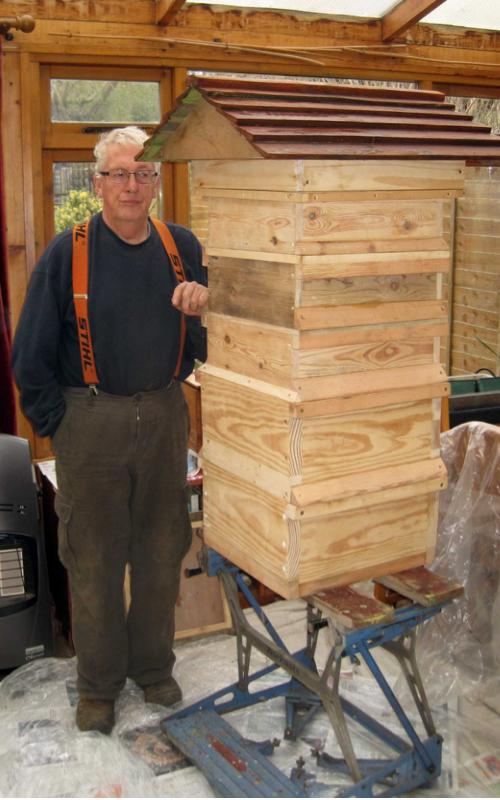
Work in progress.
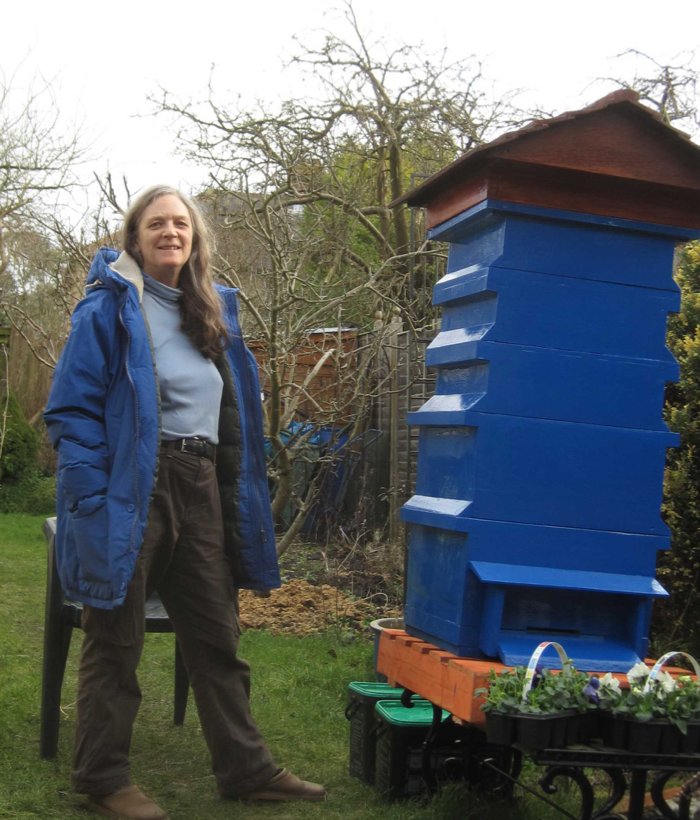
Mary with one of the finished home-made ("Hilton") hives. Based on an Irish design with a double brood box to promote new swarms.
Rather than rob the bees of their over-winter stores (honey) as commercial operations do and replace it with inferior sugar-water, which some authorities claim is partly responsible for poor colony health and world-wide colony loss, we decided to use these hives purely to promote the production of new colonies (swarms).
In the five years of their existence we have counted at least 16 new swarms released into the surrounding countryside,
but there will have been many more that we weren't there to witness. A pity that more local allotments have not followed suit...
Shortly after the hive-building project ended, we were offered sections of massive ancient beech trees from Headington Hill House
by a friendly forester.
These were originally intended as firewood logs, but we realised that some of the hollow sections might make excellent natural
bee-hives and proceeded to keep back some suitable ones.
Nige and Tim dragged them up to the waste with their Landrovers and started work on them in situ:
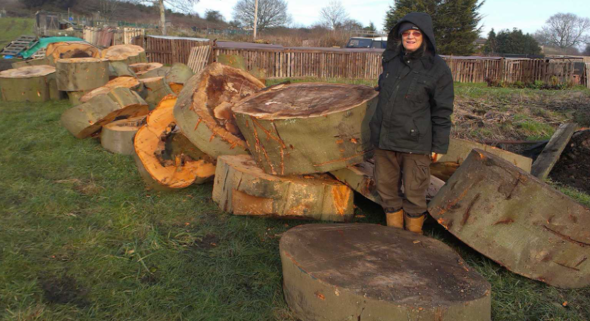
Very heavy Beech sections as delivered. Mary for scale.

After Tim had inserted cross pieces to hold honey combs.
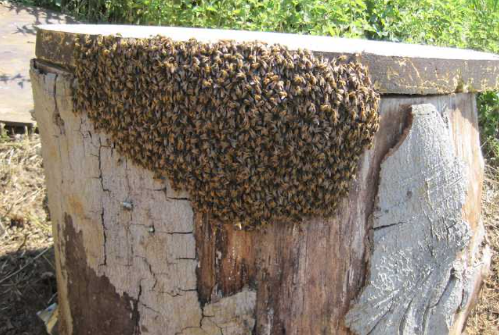
Swarm of bees just before the log hives were completed! Obviously keen...
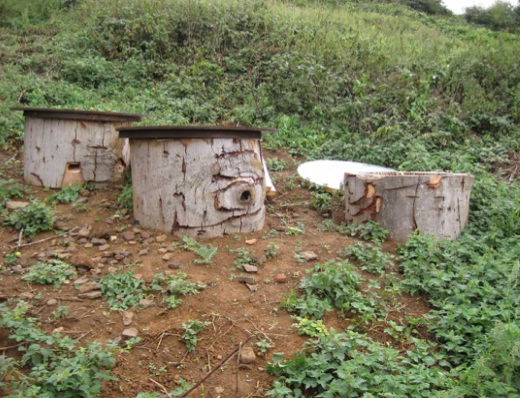
14th August 2015: First two log hives complete. Located on the waste-land at the top of our site above the container unit. The colony is still active in 2020 and we aim to collect new swarms locally to occupy the empty ones; when time permits...
In early 2020 the Covid pandemic hit the UK with a vengeance and like everybody else we went into Lockdown; with a few escape clauses authorised by the Government. One of which was to allow gardeners to travel to their allotments "for one hour per day exercise". Right!
Fiona moved swiftly to establish a Social Distance policy of two metres for all allotment tenants. And instituted a strict regime for disinfecting the lock and gates before and after opening and closing with the recommended 10% bleach solution. Failure to observe these conditions would have meant we would have had to close the allotments until further notice. Everyone has conformed to the rules and we have (so far) been able to work our plots.
Postscript: During the pandemic, several national museums and archives asked via the Media that various social groups
should keep a diary of their experiences of this period, with the intention of archiving them as historical documents in the Public Record
Office at Kew.
Thus we are currently preparing a photographic record - with tenant's observations - of our Horspath village allotments
over this time.
Fiona will distribute this to all HAA members via a PDF file. When completed, and this may take a while given the recent reinfection spike, we also intend to publish this account on our website and, who knows, perhaps in a couple of hundred years (or more!) our remote descendants will see things, and ourselves, as we saw them...
Chris Pym. HAA September 2020